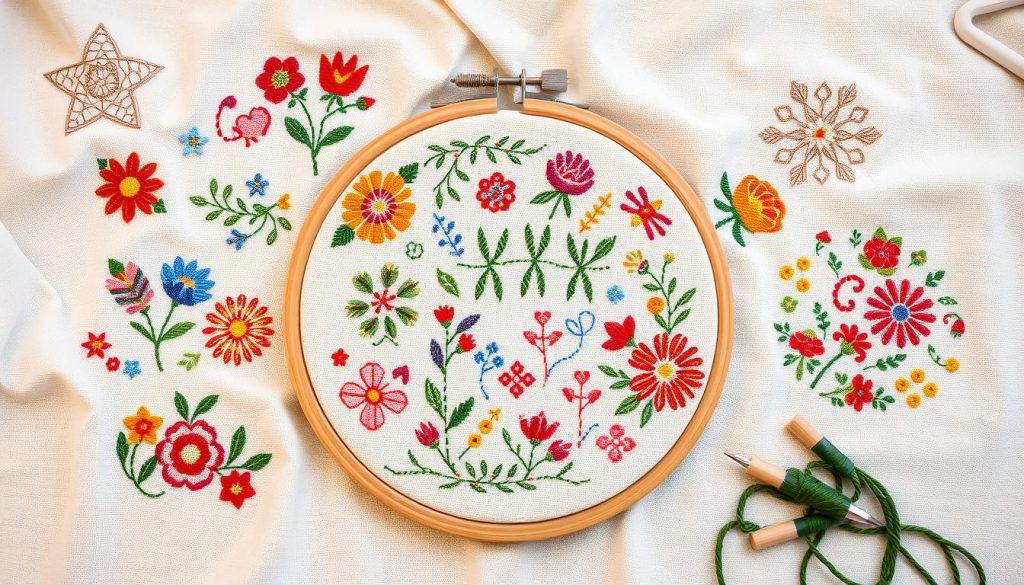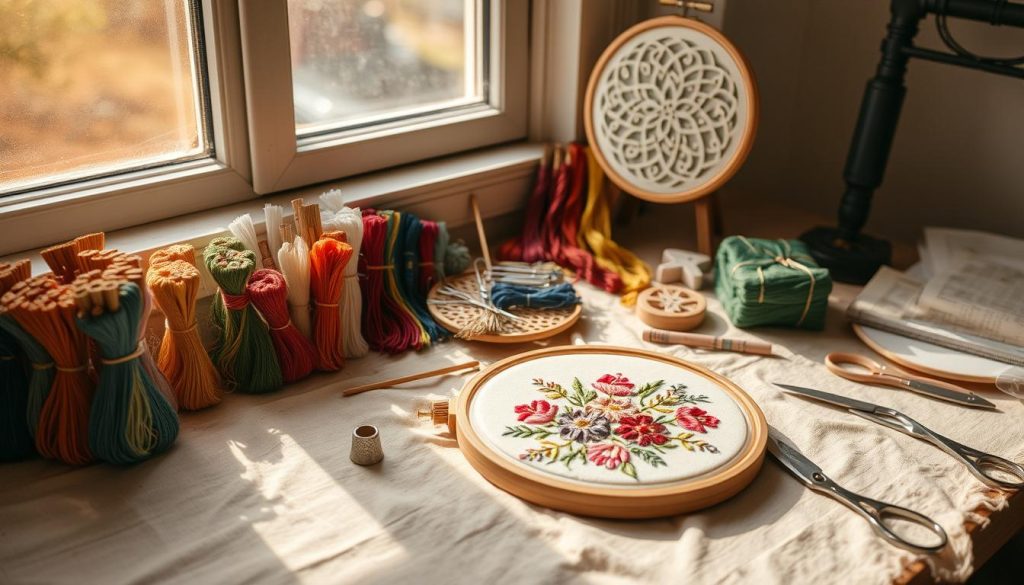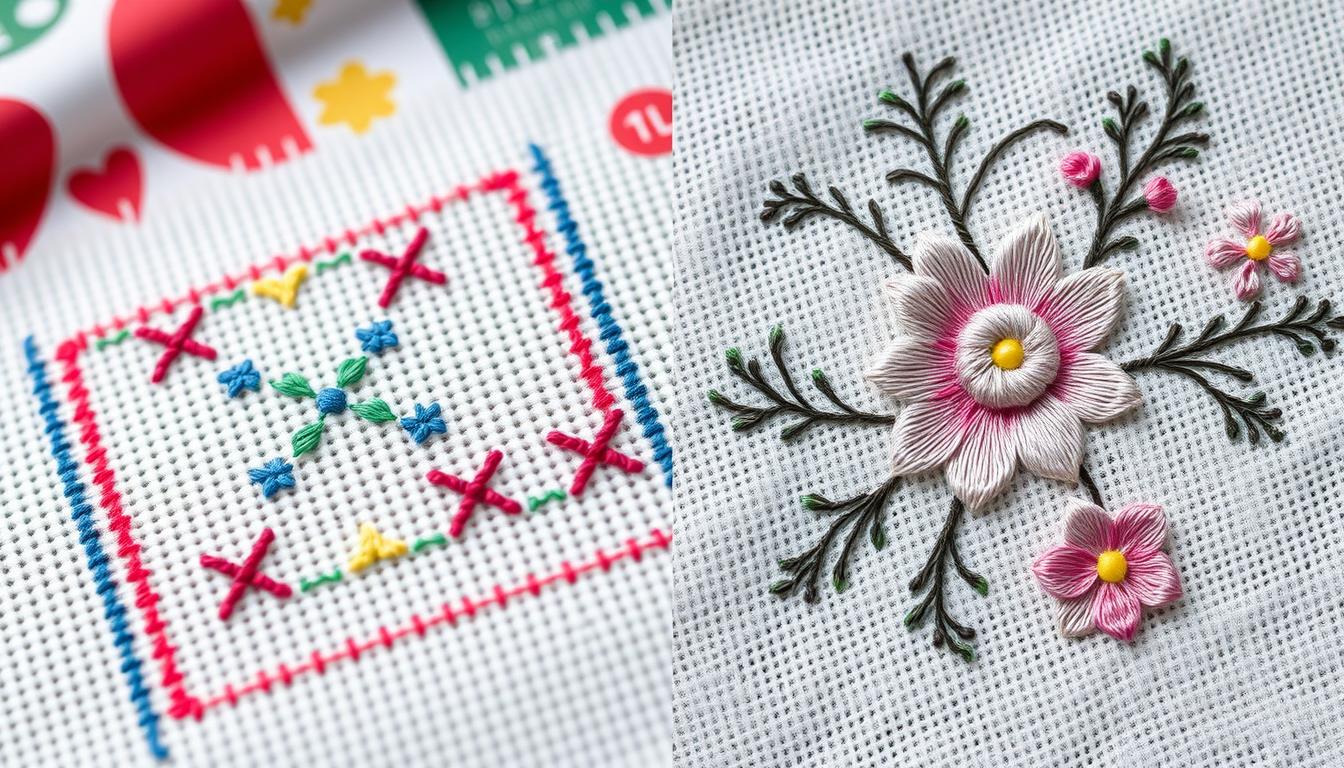Choosing between crossstitching and embroidery can be fun but tricky. Both are loved by many crafters. Knowing the key differences helps you pick the right one for you.
Cross stitch uses “x-shaped” stitches, making a grid-like pattern. It’s often done on aida fabric, which is easy to work with. Beginners find it helpful because they can count the squares. Tools like DMC Stranded Cotton and Elbesee embroidery hoops help keep the fabric tight.
Embroidery, however, has many techniques and stitches. It’s done on linen or cotton, using threads like DMC Stranded Cotton. This craft lets you get creative with intricate designs and patterns.
Key Takeaways
- crossstitching is simpler, using primarily “x-shaped” stitches and counted fabric like aida.
- Embroidery offers a wider variety of stitches and is done on fabrics like linen and cotton.
- For both crafts, DMC Stranded Cotton is a popular choice for threads due to its quality.
- Embroidery hoops, such as those from Elbesee, are essential for maintaining fabric tension.
- Cross stitch is beginner-friendly, while embroidery offers more opportunities for creative freedom.
Understanding Cross Stitch
Cross stitch is a classic needlework art that makes X-shaped stitches on fabric. It’s a hobby that mixes creativity with detail, great for those who love precise work.
What Is Cross Stitch?
So, what is cross stitch? It’s about making X-shaped stitches on Aida fabric or linen. Each stitch is part of a bigger pattern, like following a grid. The charts show a grid with squares, each square for one stitch, making it easy for beginners.
Types of Stitches in Cross Stitch
There are many stitches in cross stitch to add detail to your designs. The main ones are:
- Full Cross Stitches: The basic stitch, making an X.
- French Knots: Small knots for texture.
- Half and Quarter Cross Stitches: For detailed work and smooth curves.
Embroidery floss is six strands of thread twisted together. Stitching with one or two strands at a time is best for good results.
Popular Cross Stitch Patterns and Kits
There are many cross stitch patterns and kits, from classic to modern. Kits usually have everything you need, like charts, threads, and a needle. Brands like DMC and Dimensions make high-quality kits for all skill levels.

Supplies Needed for Cross Stitch
To start crossstitching, you’ll need some basic supplies:
- Aida Fabric: Comes in counts like 11 or 14 holes per inch.
- Embroidery Floss: Six-strand thread, usually cotton, to be separated.
- Needles: The right size depends on the fabric.
- Embroidery Hoop: Optional but helps with fabric tension.
- Pattern Chart: Shows the design with color codes and where to stitch.
Start stitching from the center of the fabric for a well-centered design. Here’s a checklist to make sure you’re ready:
| Item | Details |
|---|---|
| Aida Fabric | Check for different counts like 11 or 14 holes per inch |
| Embroidery Floss | Six strands, often separated for use |
| Needles | Select based on fabric type |
| Embroidery Hoop | Optional, helps maintain tension |
| Pattern Chart | Includes color codes and symbols |
What Is Embroidery?
Embroidery is the art of decorating fabric with needle and thread. It’s different from cross-stitch because it lets you create free-form designs. This makes intricate and lifelike artworks possible. With many techniques and materials, embroidery offers endless creative possibilities.

Different Types of Embroidery
Knowing the types of embroidery helps you pick the right one for your project. Here are some common ones:
- Hand Embroidery: Uses embroidery stitches to make unique, personal pieces.
- Machine Embroidery: Makes complex designs quickly, often used in the apparel industry.
- Needlepoint: Works well on sturdy materials, using stitches like tent and Gobelin.
Stitch Varieties in Embroidery
There are many embroidery stitches that give different textures and effects. Here are some favorites:
- Satin Stitch: Makes a smooth, filled area.
- Chain Stitch: Looks like a chain, great for outlining.
- French Knot: Adds dimension with small knots.
Tools and Fabrics for Embroidery
Choosing the right embroidery tools and embroidery fabrics is key for great projects. You’ll need:
- Needles: Sharp needles for detailed work.
- Hoops: Keeps the fabric taut for easy stitching.
For fabrics, cotton and linen are popular. They work well for many designs.
Popular Embroidery Designs
Popular embroidery designs range from simple to complex. They can decorate everyday items like tote bags, t-shirts, and home decor. This adds a personal touch to anything.
Comparing Techniques and Styles
When we look at crossstitching and embroidery, we see two different ways of creating art. Cross stitch uses X-shaped stitches on a grid, making it structured. It’s often done on Aida cloth or linen. The time it takes can range from a few hours to weeks, depending on the design’s size and detail.
Cross Stitch Techniques
At the heart of cross stitch are the X-shaped stitches. This makes it easy for beginners to start. People often use Aida cloth or linen, which has a clear grid for stitching. Projects like bookmarks, brooches, and coasters are popular because they show off the fabric’s structure and color.
Interestingly, 40% of people choose cross-stitch because of its structured nature.
Embroidery Techniques
Embroidery, on the other hand, offers more freedom with different stitches and fabrics. You can use wool, quilting cotton, or even canvas for hand embroidery. It’s great for adding details to clothes or home decor. About 60% like using backstitch for outlining because it adds elegance.
Design Flexibility and Creativity
When it comes to design, crossstitching and embroidery have their own strengths. Cross stitch is known for its methodical process, leading to precise results. Embroidery, however, allows for more creativity and personal expression. Projects can range from custom patches to elaborate home decor, showing off the maker’s style.
Complexity and Skill Levels
The complexity of these crafts differs. Cross stitch is simpler, with its X-shaped pattern, making it great for beginners. It’s perfect for starting with simple projects and then moving to more complex ones. Embroidery, with its variety of stitches, requires more skill and practice, especially with techniques like backstitch.
| Aspect | Cross Stitch | Embroidery |
|---|---|---|
| Techniques | Repetitive X-shaped stitches | Variety, including backstitch, satin stitch, etc. |
| Fabrics | Even-weave fabrics like Aida cloth, linen | Cotton, weaver’s cloth, canvas, wool, quilting cotton |
| Time Investment | From a few hours to several weeks | Depends on design complexity and skill level |
| Design Flexibility | Structured, predictable results | Artistic freedom, custom designs |
| Skill Levels | Beginner-friendly | Advanced, requires precision |
Choosing the Right Craft for Beginners
Starting with needlework can be exciting. But picking the right craft is key to a good experience. We’ll look at why crossstitching is great for beginners and the best embroidery for newbies. We’ll also talk about mistakes to avoid.
Why Cross Stitch Is Great for Beginners
Cross stitch is simple, making it perfect for beginners. You need just a few things: fabric, thread, and a needle. It’s easy to follow and helps you learn quickly.
One tip is to avoid knots, which can make your work look bumpy. Leave enough thread to weave under at least three stitches when changing colors. Start with simple designs to build your skills.
Best Type of Embroidery for Newbies
Beginners should start with easy embroidery. Start with basic stitches like the running stitch and satin stitch. Using hoops helps keep your fabric tight.
Choose the right thread and fabric for your embroidery. Use one or two strands of embroidery floss at a time. Cotton or linen fabrics are good for beginners because they’re easy to work with.
Common Beginner Mistakes to Avoid
Beginners often make a few mistakes. Here are some to watch out for:
- Choosing the wrong fabric: Use Aida for crossstitching and cotton or linen for embroidery.
- Incorrect thread management: Separate your floss strands correctly and use the right amount.
- Poor tension control: Keep your stitches even by using light tension.
- Skipping the preparation: Secure your thread at the start and end to prevent it from coming undone.
- Ignoring the grid: Counted crossstitching needs careful counting and alignment. Start in the middle and follow the pattern.
By avoiding these mistakes, beginners can have a great time with needlework.
Conclusion
When comparing crossstitching and embroidery, it’s clear they both have their own perks. Knowing the differences helps you pick the right needlework for you. Cross stitch is great for beginners because it’s simple and has structured patterns. It’s also known for being calming.
Embroidery, however, lets you be more creative and flexible. It’s perfect for those who love trying out new styles and techniques.
Thinking about the cost and materials is also key. Cross stitch kits are usually cheap, costing between $5 to $10. They use simple materials like 14-count Aida fabric. Embroidery, though, might need special tools and fabrics, which can be pricier.
Hand-dyed and premium fabrics can also raise the cost, especially for big projects. So, your budget matters.
Reflecting on crossstitching and embroidery, remember what you like best: creativity, ease, or style. There’s no single right choice. But, knowing what you’ve learned, you can start your needlework journey with confidence.
Whether you want to make cross-stitch gifts or explore embroidery, start with what excites you. Happy crafting!
